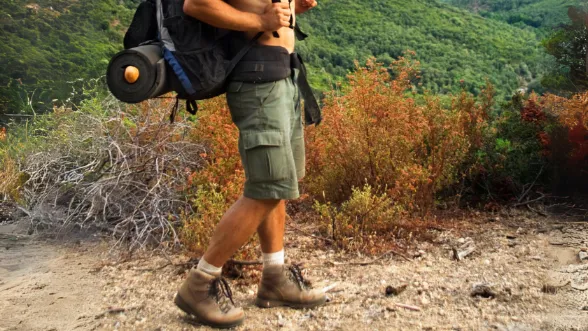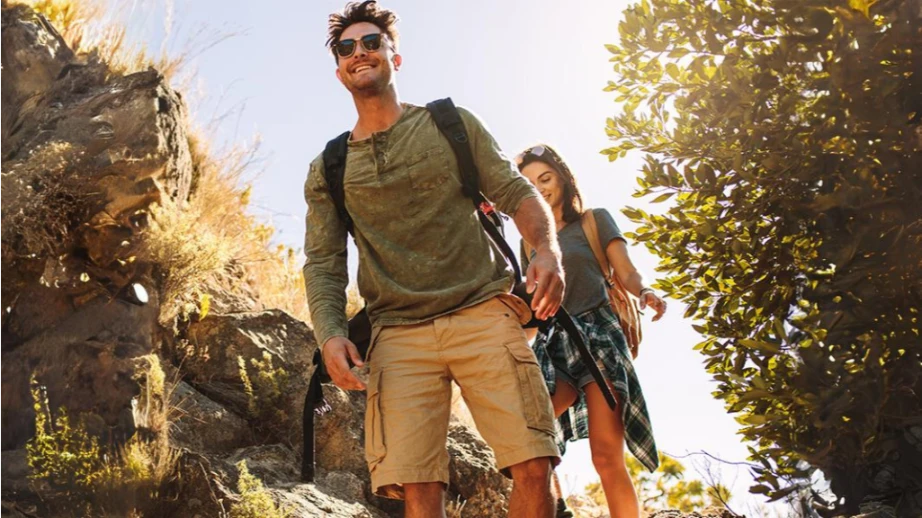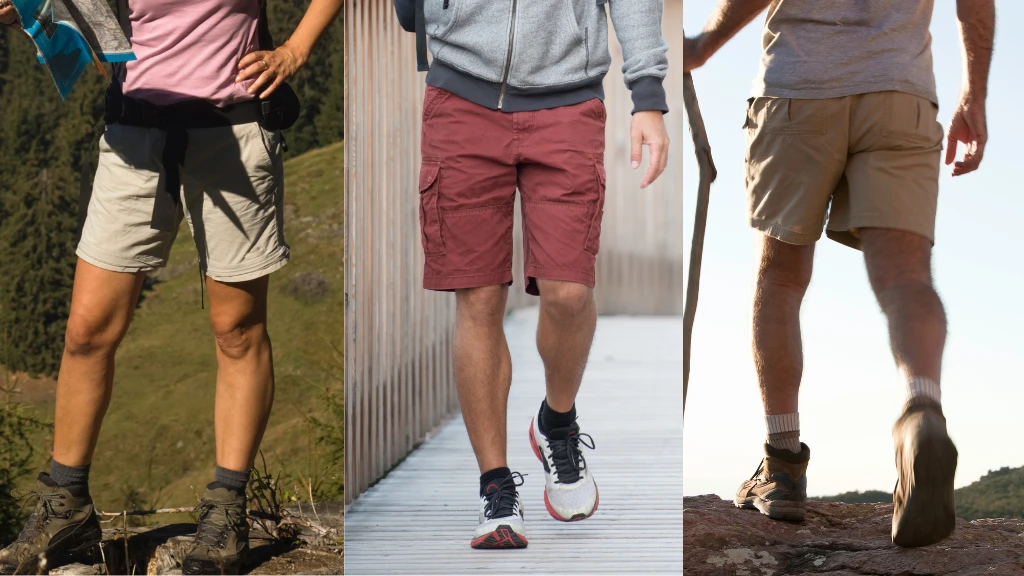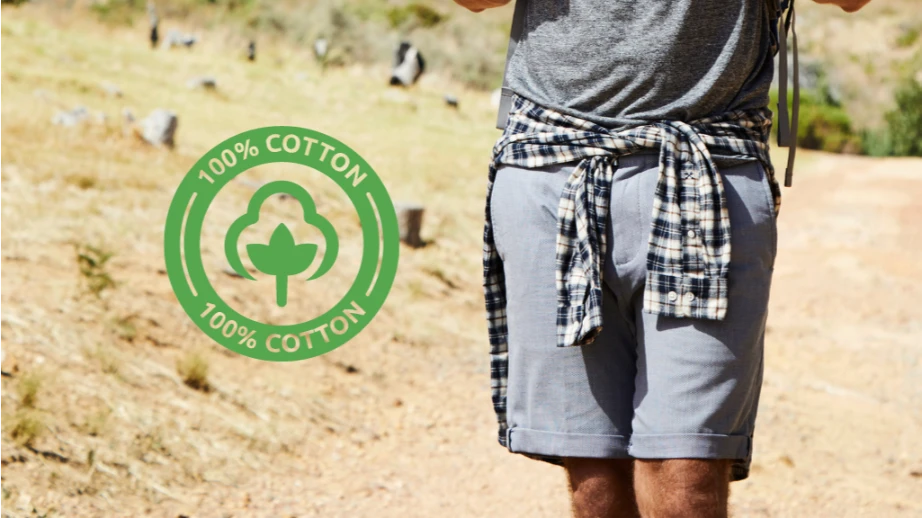Cargo shorts have consistently been my go-to but as much as I adore them for their unparalleled storage space, they’re not without their drawbacks, mainly the extra weight and, sometimes, the hit to your wallet.
It’s a trade-off, but one that many of us are willing to make for the convenience and practicality these shorts bring to our hikes.
In this article, we’re going to explore the pros and cons of cargo shorts in more detail.
Are Cargo Shorts Good for Hiking?
Cargo shorts are a great choice for hiking, mainly because of their amazing storage space. These shorts are also comfortable enough to wear all day, durable enough to withstand the elements, and some even come with water resistance.
They’re a bit heavier and thicker than your average shorts, but the trade-off is usually worth it for many hikers.
Pros of Cargo Shorts for Hiking

Extra Storage Space
Every inch of space counts on the trail, especially if you’re trying to keep your pack light. Ideal cargo shorts aren’t just any old shorts with extra pockets slapped on. They’re a carefully thought-out piece of gear.
Look for ones with at least 5 pockets, although you can find options with 6+ pockets, REI Co-op Sahara Cargo Shorts being the prime example here. This number provides the perfect balance to carry all your essentials without turning into a walking storage unit.
Keep in mind that each pocket needs to be deep enough to actually hold your stuff securely. There are too many cases of hikers who watched their phone taking a dive down the mountain while bending over to tie shoes.
That’s why a pocket depth of around 5 inches is important. It’s deep enough to keep your items safe but not so deep that you have to go fishing for them.
Comfort and Mobility
Most cargo hiking shorts have all necessary features that allow for a full range of motion.
First off, built-in underwear is something you might not think about until you’ve spent hours on a trail, dealing with chafing. This built-in feature can actually reduce that annoying friction and allow for better airflow.
The gusseted crotch is another feature that gives you freedom to move in all directions without any pinching or pulling.
You also want cargo shorts that boast 2 or 4-way stretchability. This stretchiness allows for unrestricted movement when you’re climbing over rocks or jumping across streams. Although it’s not easy to find cargo shorts with 4-way stretch, prAna Stretch Zion Shorts II is one of the examples that are exceptionally stretchy.
Finally, you can expect your cargo shorts to feature an adjustable waistband, usually capable of tweaking up to 2 inches. This allows for a perfect fit, no matter how much post-hike meal fills you up.
Durability and Security
The construction plays a huge role in cargo shorts. Some options come with double-stitched seams which add an extra layer of durability, ensuring that even if one stitch fails, the other will hold up.
There are also pocket security features. We’ve already discussed the importance of your pocket’s depth, but many cargo shorts also come with useful zippers that act like a personal bodyguard for your belongings, keeping them safe, no matter how rigorous the hike.
Water Resistance
Cargo shorts with a water-resistant treatment help keep you dry, comfortable, and on the move. I always look for water-resistant shorts because it allows me to skip packing an extra pair of waterproof pants, especially on shorter hikes or in milder conditions.
Now, when I say water-resistant, I’m talking about shorts that can usually handle a good soaking up to a hydrostatic head of 10,000 mm. In simple terms it means that your shorts can withstand the pressure of a column of water that’s 10,000 mm tall without letting moisture through.
And even if your shorts do get a bit wet (no fabric is entirely invincible), water-resistant materials usually dry much faster than their non-treated counterparts so you won’t be stuck in soggy shorts for long.
Your cargo pockets aren’t just for show either. When they’re part of water-resistant shorts, they offer a safer spot for your phone, map, or snacks. While I wouldn’t suggest taking a swim with your electronics in your pockets, it’s nice to know they have some protection against light rain or splashes.
Sustainability
Brands like REI or prAna often use recycled materials in their cargo shorts. The material that is often used is recycled polyester. It gives a second life to plastic bottles and other post-consumer plastic waste, transforming them into a durable, high-quality material perfect for hiking gear.
What I particularly love is that making cargo shorts from recycled polyester uses about 33-53% less energy compared to creating virgin polyester. That’s a significant drop in carbon footprint!
The process also cuts down on water usage, which is always a win when we’re talking about eco-friendly practices.
Cons of Cargo Shorts for Hiking

Cargo Shorts Are Heavy
Cargo shorts might be adding to your workload. They are typically 4, 5, or even 6 ounces heavier than their sleeker counterparts.
So, should you ditch cargo shorts altogether? Not necessarily. It’s about finding the right balance for your hike. Here are a few tips:
- Assess the Hike: For short, leisurely walks where you want your essentials within easy reach, cargo shorts might still be king. But for those grueling day-long treks? Consider lighter options.
- Pack Smart: If you do opt for cargo shorts, think carefully about what you really need in those pockets. Every little bit adds up.
- Try Alternatives: There are lightweight hiking shorts out there that still offer storage solutions, such as zippered pockets or attachable gear loops.
Potential for Overheating
Cargo shorts are usually heavier and thicker than shorts with less pockets. While durability is great, these materials can also trap heat close to your body.
As much as I love my REI Co-op Sahara Cargo Shorts, I can’t imagine trekking through the Grand Canyon in July wearing them. My body would start to heat up and they would suddenly feel suffocating.
To combat this, look for cargo shorts with moisture-wicking properties to help keep you cool and dry. Additionally, opt for lighter colors that reflect the sun’s heat instead of absorbing it. This can make a big difference in your overall comfort level on hot hikes.
Price
The price tag on a good pair of cargo shorts isn’t always the most wallet-friendly, ranging anywhere from $40 to over $150. From my own pocketbook’s experience, I’d steer clear of anything less than $40 if you’re after durability and functionality that won’t fall apart on the first hike.
Conclusion
Choosing cargo shorts for your hikes? You really can’t go wrong unless you find yourself battling the sweltering heat of an extremely hot day. In those rare instances, you might want to lean towards lighter, more breathable options.
But, setting those considerations aside, cargo shorts stand out as a stellar choice for practically ANY hike. Especially if you, like me, have a soft spot for storage space.

Lukas Heller
Hey there! I’m Lukas, co-founder of BigfootHiking.com, alongside my adventurous wife Martha. Originally from Germany, I landed in Phoenix, Arizona, in 2015, where I’ve been scouting out new trails ever since (though they’re getting scarce!). By day, I’m a software developer, but my heart belongs to hiking – I’m always plotting our next trip. When I’m not coding or on the trails, you’ll find me hanging out with our Pit Bull, Zeus.





